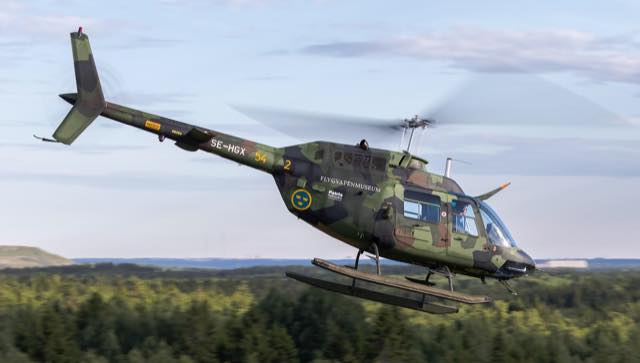Co-operation – the need for a new helicopter
Both the Swedish Army and Navy had procured the French Alouette II as their first light helicopters, calling them Hkp2. By the end of the 1960s requirements had increased, and a search began for a more advanced and larger replacement for the Hkp2. By this stage it had become apparent that co-operation between the various defence services was better for practical and economic reasons. Since both the Army and Navy aviation branches needed a new light helicopter, the Royal Swedish Air Force Materiel Administration (as it then was) arranged the procurement of a new helicopter, which would be known as the Hkp6.
The Defence Materiel Administration carried out the procurement process between 1967 and 1969. Several manufacturers entered proposals for the initial Requests for Quotations on April 28th 1967. However a couple of these bids were only at the prototype stage, even though the MBB BO 105 was one, which would come up again and have another chance later on.
It soon became quite obvious that there was really only one helicopter that for the most part met the requirement specifications, and also was not too expensive. In addition, its delivery time was by far the shortest. This was the Bell Jet Ranger 206. So a contract was drawn up and signed as early as December 29th 1967. Swedish Army Aviation ordered 22 helicopters and Naval Aviation 10.
Overall it can be said that the Hkp6 procurement process was relatively quick and smooth.
Swedish Army Aviation’s new workhorse
Within Swedish Army Aviation the Hkp6 was to a large extent given the same tasks as the Hkp2 had had. Reconnaissance, liaison flights, senior officer visits and general transport. They were also to some extent used for medical transport. All the flying career officers within Army Aviation became familiar with the Hkp6 since they were used for basic tactical aviation training.
To begin with there were some problems with the helicopter heaters that really didn’t have enough capacity, and among other things refused to work when they were most needed. They were obviously not suited to Swedish winters. However after a programme of modifications the problems were solved.
The Hkp6 would fly many hours for the Swedish Defence forces but unfortunately not without some accidents. The most tragic was when helicopter Z67 collided with snow on a frozen lake on March 14th 1974. The pilot and a conscript of the Parachute Ranger School were killed.
Another accident took place during an exercise in 1975 when the crew of Z79 lost control of their machine after a dummy attack from an SK60 (Saab 105) aircraft whereupon the helicopter hit the ground. Fortunately the crew survived, although the pilot and flight engineer had injured feet and ankles.
Testing for the future
There had long been an interest in Army Aviation concerning armed helicopters, and of particular interest was the possibility to attack enemy armoured vehicles. The French, who had from early on been developing anti-armour missiles, had already tried arming the Alouette II with SS11 anti-armour rockets. It was however in 1971 that the concept was tested in battle for the first time, by the USA during the war in Vietnam.
In Sweden it was considered that one of the possible scenarios in the case of possible war would be that the Soviet Union and Warsaw Påact countries would in the course of hostilities against NATO try to cut off Norway by attacking via Northern Finland and Northern Sweden.
An important component of the Soviet Union’s arsenal was their preponderance of tanks which were well supported by infantry carried in armoured personnel carriers. Helicopters equipped with armour-piercing missiles offered a possibility of being able to quickly concentrate enough firepower within a confined area to prevent a powerful attack made by enemy armoured vehicles.
Four Hkp6 helicopters were rebuilt between 1977 and 1978, whereby they were among other things equipped with special sights connected to video cameras in order to test the concept. These tests led to the procurement of the Hkp9 MBB BO 105 helicopter, which is a completely different story.
The Swedish Navy’s little hunter
Swedish Naval Aviation procured, as previously mentioned, 10 Hkp6 to replace the elderly Hkp2s. These were designated Hkp6B and utilised as light transport helicopters, but also for hunting submarines.
For submarine hunting the Hkp6 operated in conjunction with the much larger Hkp4. Two Hkp4 and one Hkp6 formed a submarine hunting group. The large Hkp4s were equipped with hydrophones, which were not suitable for the smaller Hkp6, which were instead provided with radar for surface searching. They could also carry a small weapon load which meant that they could perform armed missions themselves against eventual submarines, while the heavier helicopters used their hydrophones for searching and guiding the Hkp6 to the target.

Flygvapenmuseum (The Swedish Air Force Museum) currently has an airworthy Hkp6, the former number 54 that now bears the civil registration SE-HGX. In June 2019 it flew, together with the Aeroseum’s airworthy Hkp4 Y70 as a reduced submarine hunting group as a display at the Aeroseum’s Children’s Flying Weekend. Photograph Tim Jansson
The merger
There took place in 1998 a major change in Swedish Defence helicopter aviation. From the start the three separate branches of defence forces had independently formed their own helicopter units, each adapted to meet their own specific requirements. But now the Army, Navy and Air Force rescue helicopters were merged to form a new force, the Helicopter Fleet. It can be said to be a reminder of how the Swedish Air Force was created in 1926 by merging the Army’s flying unit at Malmen and the Navy’s aviation unit.
Whether the long term effects of this change will be good, bad or simply a new way to operate in the future remains to be seen. The Hkp6 was finally taken out of service in 2004.
